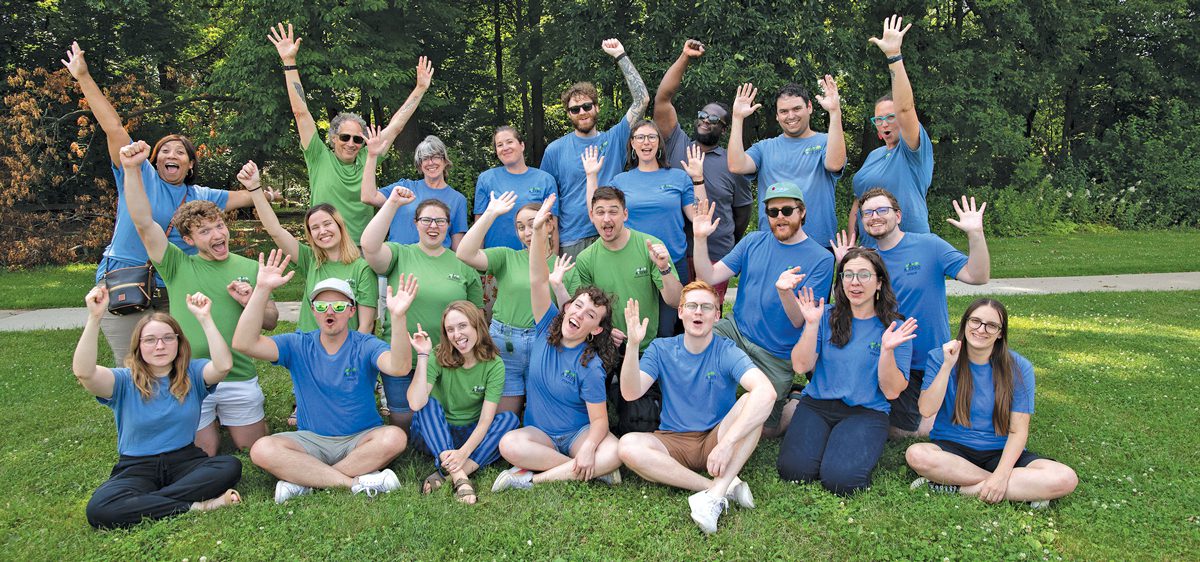
The staff of the Office of Sustainability and Innovations are tasked with achieving community-wide carbon neutrality by 2030. They’re working with 130 different community organizations, 100 volunteer A2Zero Ambassadors, and nearly a dozen city departments. | Photo by Mark Bialek
In June, the Ann Arbor Office of Sustainability and Innovations (OSI) celebrated the fourth anniversary of A2Zero. The $1 billion climate action plan, which aims to attain community-wide carbon neutrality by 2030, was approved unanimously by the city council after Ann Arbor declared a climate emergency in 2019.
To reduce the city’s 2.1 million metric tons of annual carbon emissions, A2Zero’s eighteen-person staff has developed seven overarching strategies, including measures to power the electric grid with renewable energy, reduce the use of motor vehicles, and promote community engagement.
One of the ways they engage the community is through the annual A2Zero Week. From June 9 to 15, the OSI celebrated with bicycle events, repair clinics, trivia and game nights, educational programming, films, and parties with vegan fare courtesy of VegMichigan. The weeklong celebration came to a close just days before the June 28 Supreme Court ruling on the Chevron Doctrine, which undercut the EPA’s authority to regulate air and water pollution. The weakening of federal environmental policies underscores the importance of local climate-change initiatives like A2Zero.
“Locals have been leading climate work for decades,” says OSI director Missy Stults. “We do not have the luxury of playing politics that other folks are playing on a national stage. Local communities are stepping up to find solutions because they don’t have a choice.”
Related: Sustainable Energy Utility
A2Zero
Missy Stults
Ann Arbor residents have already begun to feel the impact of climate change. Since the 1950s, Ann Arbor has witnessed a 44 percent increase in annual precipitation and a 37 percent increase in rainfall during extreme weather events. By 2050, OSI projects that the average air temperature will rise by 3 to 7 degrees Fahrenheit, including twelve to thirty-six more days when temperatures exceed 90 degrees.
The increases in precipitation and air temperature pose a serious threat to public health as infrastructure struggles to hold up against the rapid pace of climate change. During the June heatwave, for example, 9,000 residents of southeast Michigan suffered power outages for three days because of a storm.
Over the past year, A2Zero took numerous actions against the increasingly palpable effects of climate change, including installing 250 KW of solar panels, securing funding to decarbonize the Bryant Community Center, electrifying 25 percent of the city’s light-duty vehicles, launching the Ann Arbor Area Sustainable Food Business Coalition, and more.
Stults says A2Zero’s accomplishments depend on public support. “The community is at the heart of our work. There’s a key word in our vision, which is together—that none of this can be done if we’re not working together.”
In November of 2022, 71 percent of Ann Arbor voters approved a tax proposal to subsidize A2Zero’s climate action. In the past year, OSI strengthened its community partnerships by working alongside 130 different organizations in Ann Arbor, 100 volunteer A2Zero Ambassadors, and nearly a dozen city departments.
“We need our community to be involved in whatever way they want to be,” Stults says. “So I would encourage folks to come to an event, to raise their hand. There are so many ways to get involved. This plan is ours, but this work is yours. There is space for you in this movement, and we cannot wait to welcome you into it.”